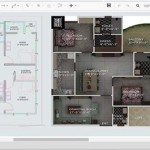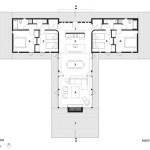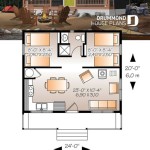How To Find the Floor Plan of an Old House
Discovering the floor plan of an old house can be an enthralling endeavor, offering valuable insights into the property's history, architectural design, and potential for renovation or preservation. Finding these elusive blueprints, however, often requires a combination of research, detective work, and a good measure of patience. This guide outlines various avenues to explore when searching for the floor plan of an old house, providing practical advice and resources to aid the process.
Before embarking on the search, it is important to define the reasons for needing the floor plan. Are you planning a renovation, tracing the property's historical evolution, or simply satisfying curiosity? Understanding the objective will help focus the research efforts and determine the level of detail required in the floor plan.
The process may involve navigating multiple sources and potentially uncovering partial or inaccurate information. A thorough approach, combining both online and offline resources, will increase the chances of success. It is also prudent to manage expectations; the floor plan may not always be readily available, and in some cases, it may have been lost or destroyed over time.
Key Point 1: Exploring Official Records and Archives
Official records and archives represent a primary source of information for locating floor plans. These repositories often contain documents related to building permits, property assessments, and historical surveys, which might include architectural drawings or floor plans.
Local Government Offices: The first place to investigate is the local government, specifically the building department, planning department, or historical preservation office. These departments typically maintain records of building permits and property assessments. Building permits, in particular, often require the submission of floor plans as part of the approval process. Accessing these records may involve submitting a formal request and paying a fee. The process and accessibility vary depending on the jurisdiction, so it's essential to contact the relevant department to inquire about their specific procedures.
County Recorder's Office: The county recorder's office is another valuable resource. This office maintains records of property ownership, deeds, and mortgages. While floor plans are not always included in these records, they might be attached to the original deed or a subsequent modification. Searching the property's chain of title may reveal documents that contain a floor plan or reference its existence.
State Archives and Historical Societies: State archives and historical societies often hold collections of historical documents, maps, and architectural drawings. These institutions may have records related to specific properties or neighborhoods, including floor plans that were created during the construction or renovation of the house. Accessing these archives may require visiting the facility in person or searching their online databases. Some institutions also offer research services for a fee.
National Archives and Library of Congress: In rare cases, floor plans for older or historically significant houses may be found in the National Archives or the Library of Congress. These institutions hold vast collections of historical documents and architectural drawings, particularly for properties that have national historical significance or were designed by prominent architects. Searching these collections may require significant research effort, but it can yield valuable results.
When searching official records, it is crucial to have as much information about the property as possible, including its address, legal description, past owners, and approximate construction date. This information will help narrow down the search and increase the chances of finding the desired floor plan.
Key Point 2: Investigating Private and Specialized Resources
Beyond official channels, private and specialized resources can provide unique access to floor plans and architectural information. These resources include historical societies, architectural firms, and online databases.
Local Historical Societies and Genealogical Societies: Local historical societies and genealogical societies often maintain collections of historical photographs, maps, and documents related to the area. These societies may have floor plans or other information about the house and its previous owners. Networking with members of these societies can also provide valuable leads and insights.
Architectural Firms and Archives: If the house was designed by a known architect or architectural firm, their archives may contain the original floor plans. Contacting the firm or searching their archives can be a fruitful avenue of investigation. Even if the original firm no longer exists, its records may have been transferred to another firm or an archival institution. Specialized architectural archives may also house collections of architectural drawings from various sources.
Online Databases and Websites: Several online databases and websites specialize in historical building information and architectural drawings. These resources may include digitized floor plans, historical maps, and property records. Examples include Ancestry.com, Newspapers.com, and specialized architectural archive websites. Utilizing these databases requires careful searching and may involve subscription fees, but they can provide access to a wealth of information.
University Libraries and Archives: University libraries and archives often hold collections of historical documents and architectural drawings, particularly for buildings designed by prominent architects or located within the university's geographical area. Searching these collections may require visiting the library in person or searching their online databases. Some universities also offer research services for a fee.
When exploring private and specialized resources, it's imperative to approach each source with a specific research question and to critically evaluate the information obtained. Cross-referencing information from multiple sources is essential to ensure accuracy and completeness.
Key Point 3: Employing Visual Investigation and Architectural Analysis
If formal records and archives prove unfruitful, conducting a visual investigation of the house itself and applying architectural analysis techniques can provide valuable clues about the original floor plan.
Careful Observation and Measurement: A thorough walk-through of the house, paying close attention to the layout, room sizes, and architectural details, can reveal clues about the original floor plan. Taking accurate measurements of each room and the overall dimensions of the house is essential. Note any unusual features, such as hidden doors, altered walls, or unexplained changes in floor level. These features may indicate modifications to the original floor plan.
Analyzing Architectural Styles and Features: Identifying the architectural style of the house and analyzing its various features, such as window placement, rooflines, and decorative elements, can provide insights into the original design. Researching the typical floor plans associated with that architectural style can help reconstruct the likely layout of the house. Resources on architectural styles and building history can be found in libraries, historical societies, and online.
Examining Structural Elements: Investigating the structural elements of the house, such as the foundation, framing, and chimney placement, can reveal clues about the original floor plan. The location of load-bearing walls, for example, will significantly influence the layout of the rooms. Examining the crawl space or attic can provide access to the framing and allow for a better understanding of the house's construction.
Consulting with Experts: Consulting with architectural historians, historic preservation consultants, or experienced contractors can provide valuable insights and guidance. These professionals have expertise in analyzing old buildings and reconstructing their original floor plans. They can identify architectural features, interpret historical evidence, and offer recommendations for further research.
When employing visual investigation and architectural analysis, it's important to document all observations and measurements carefully. Creating a sketch of the house and annotating it with relevant details can be helpful in reconstructing the floor plan. Remember that the house may have been modified over time, so the current layout may not accurately reflect the original design.
In addition to the methods described above, certain software programs can assist in drawing or recreating floor plans based on measurements and observations. These programs often include features for adding architectural details and generating three-dimensional models, aiding in visualizing the house's original layout.

9 Ways To Find Floor Plans Of An Existing House Archid

9 Ways To Find Floor Plans Of An Existing House Archid

9 Ways To Find Floor Plans Of An Existing House Archid

How To Find The Plans Or Blueprints Your Old House

Find Old House Plans Here Historic Bungalows More

Where To Get House Plans Tips For Homeowners

How To Find Old House Plans Page 1 Homes Gardens And Diy Pistonheads

How To Find The Plans Or Blueprints Your Old House

How To Find Your Old Home Blueprints Smart Ideas And Tips

Create Professional 2d And 3d Floor Plans Roomsketcher
Related Posts








